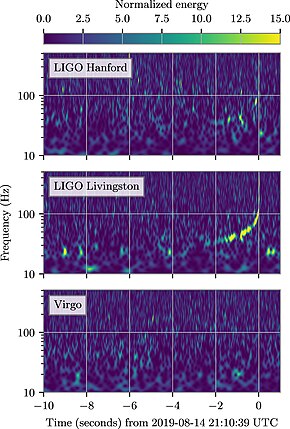GW190814
 Time–frequency representations (Chatterji et al. 2004) of data containing GW190814, observed by LIGO Hanford (top), LIGO Livingston (middle), and Virgo (bottom). Times are shown relative to 2019 August 14, 21:10:39 UTC. Each detector's data are whitened by their respective noise amplitude spectral density and a Q-transform is calculated. The colorbar displays the normalized energy reported by the Q-transform at each frequency. These plots are not used in our detection procedure and are for visualization purposes only. | |
| Instrument | LIGO, Virgo[1] |
|---|---|
| Right ascension | ??h ??m ??.??s |
| Declination | −??° ??′ ??.?″ |
| Epoch | J2000.0 |
| Distance | 241 megaparsecs (790 Mly)[1] |
| Other designations | GW190814 |
| | |
GW 190814 was a gravitational wave (GW) signal observed by the LIGO and Virgo detectors on 14 August 2019 at 21:10:39 UTC, and having a signal-to-noise ratio of 25 in the three-detector network.[1] The signal was associated with the astronomical superevent S190814bv, located 790 million light years away, in location area 18.5 deg2[n 1][1] towards Cetus or Sculptor.[2][3][4][5][6] No optical counterpart was discovered despite an extensive search of the probability region.
Discovery

In June 2020, astronomers reported details of the compact binary merging, in the "mass gap" of cosmic collisions, of a first-ever 2.50–2.67 M ⊙ "mystery object", either a possibly too-heavy neutron star or a too-light black hole, with a 22.2–24.3 M ⊙ black hole, that was detected as the gravitational wave GW190814.[1][7] According to one of the researchers, “We don’t know if this object is the heaviest known neutron star or the lightest known black hole, but either way it breaks a record.” The mass of the lighter component is estimated to be 2.6 times the mass of the Sun, placing it in the aforementioned mass gap between neutron stars and black holes.[1][8][9][10][11][12]
Regarding the absence of an optical counterpart to the gravitational wave, one of the researchers said, "Observatories around the world carried out an intensive search for any light-show produced by the merger. We were able to show that if any light was released, it must have been extremely faint to avoid detection. This means that if the lighter companion was a neutron star, its more massive black hole partner may have simply swallowed it whole! On the other hand, if the collision involved two black holes, it's not likely that it would have shone with any light."[8]
See also
Notes
- ^ The area of the sky within which it was possible to localize the source.
References
- ^ a b c d e f Abbott, R.; et al. (23 June 2020). "GW190814: Gravitational Waves from the Coalescence of a 23 Solar Mass Black Hole with a 2.6 Solar Mass Compact Object". The Astrophysical Journal Letters. 896 (2). doi:10.3847/2041-8213/ab960f. Retrieved 24 June 2020.
{{cite journal}}: CS1 maint: unflagged free DOI (link) - ^ Staff (23 June 2020). "GraceDB — Gravitational-Wave Candidate Event Database - Superevent Info - S190814bv". Pennsylvania State University. Retrieved 24 June 2020.
- ^ Starr, Michelle (16 August 2019). "Early Reports Indicate We May Have Detected a Black Hole And Neutron Star Collision". ScienceAlert.com. Retrieved 16 August 2019.
- ^ Mandelbum, Ryan F. (26 August 2019). "Mystery Deepens Around Newly Detected Ripples in Space-Time". Gizmodo. Retrieved 26 August 2019.
- ^ Starr, Michelle (11 February 2020). "First Papers on The Black Hole-Neutron Star Merger Are In. Here's What We Didn't See". ScienceAlert.com. Retrieved 11 February 2020.
- ^ Ackley, K.; et al. (5 February 2020). "Observational constraints on the optical and near-infrared emission from the neutron star-black hole binary merger S190814bv". arXiv:2002.01950v1 [astro-ph.SR].
- ^ Staff (23 June 2020). "GW190814". LIGO Scientific Collaboration. Retrieved 24 June 2020.
- ^ a b University of Birmingham (23 June 2020). "Gravitational wave scientists grapple with the cosmic mystery of GW190814". EurekAlert!. Retrieved 24 June 2020.
- ^ Staff (24 June 2020). "Black hole or neutron star? - LIGO-Virgo scientists find mystery object in 'mass gap'". Pennsylvania State University. Retrieved 24 June 2020.
- ^ Overbye, Dennis (24 June 2020). "A Black Hole's Lunch Provides a Treat for Astronomers - Scientists have discovered the heaviest known neutron star, or maybe the lightest known black hole: "Either way it breaks a record."". The New York Times. Retrieved 24 June 2020.
- ^ Starr, Michelle (24 June 2020). "Astronomers Detect First-Ever Mystery Object in The 'Mass Gap' of Cosmic Collisions". ScienceAlert.com. Retrieved 24 June 2020.
- ^ Cho, Adrian (24 June 2020). "Gravitational waves reveal lightest black hole ever observed". Science. Retrieved 25 June 2020.
External links
- "Detections". LIGO.
- Video (2:25): GW190814 binary black hole merger – overview on YouTube (24 June 2020; Science Fellow)
- Video (1:32): GW190814 binary black hole merger (animation) on Vimeo (24 June 2020; LIGO Scientific Collaboration)
- Video (1:32): GW190814 binary black hole merger (animation) on YouTube (23 June 2020; Max Planck Institute for Gravitational Physics)
- Video (0:10): GW190814 gravitational wave from mysterious object on YouTube (23 June 2020; Gravitational-wave Open Science Center (GWOSC))



